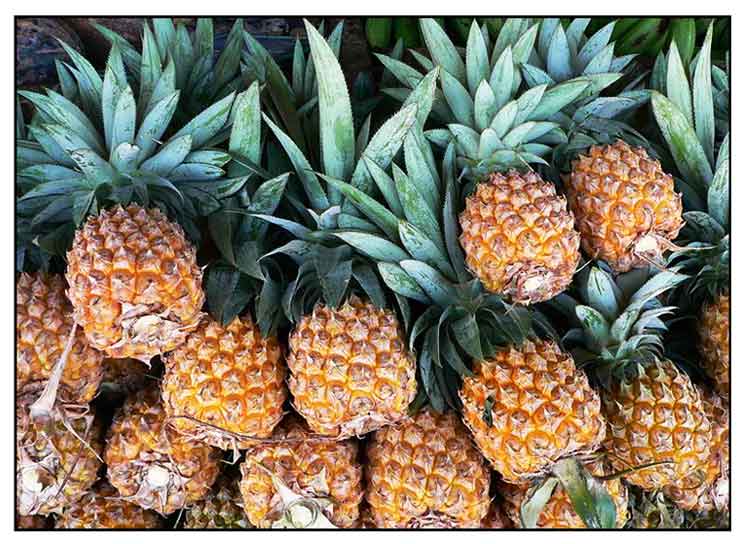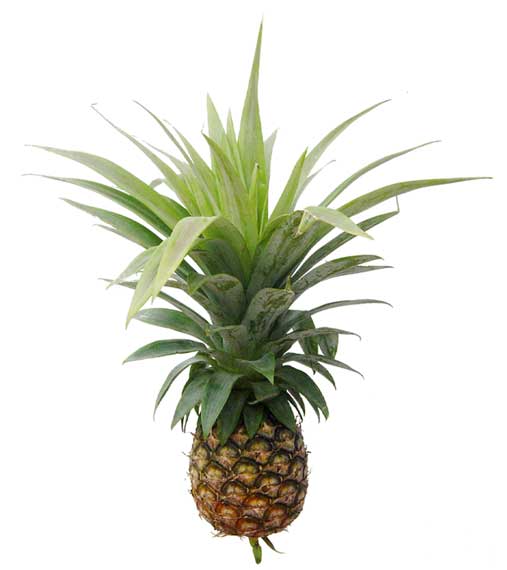|
 Botany Botany
Piña is a fruit bearing tropical plant with an erect stem, 0.5
to 1.5 meters high. Leaves are numerous, linear-lanceolate, 1
to 1.5 meters long, 5 to 7 centimeters wide, the margins sharply spiny-toothed,
green and shiny on the upper surface, pale beneath.
Leaves subtending the inflorescences are red, at least at the base and much reduced. Heads are terminal, solitary, ovoid, 6 to 8 millimeters long, much enlarged in fruit; with the bracteoles reddish, numerous, triangular-ovate to oblong-ovate, acute and imbricated. Sepals are
ovate, thick and fleshy, about 1 centimeter long. Petals are three, oblanceolate,
about 2 centimeters long, white below, violet-purple above. Mature fruit is up to 20 centimeters
or longer.
Distribution
- Widely cultivated
in the Philippines in two forms: Native and Smooth Cayenne.
- Native form was introduced by the Spaniards, smaller, fibrous with a better flavor. Smooth Cayenne was introduced from Hawaii.
Constituents
- Native variety has a higher carbohydrate content than the Smooth Cayenne variety.
- Flesh of the fruit contains sugar, 10-15% saccharose; 7-11% glucose; 1% fructose; 0.6% invert sugar; 2.74% mannite, 1% citric acid; traces of vanillin and enzyme, bromelin.
- Ash contains phosphoric and sulfuric acid, lime magnesia, silica, iron, and chlorides of potassium and sodium.
-
Contains citric acid,
phosphoric and sulfuric acid, lime, magnesia, iron, silica, sodium
and chlorides of potassium.
- Fruit yields citric and malic acids in good quantities, with moderate amounts of vitamin C.
- Bromelain is the name given to a family of proteolytic enzymes derived from Ananas comosus.
-
Antihelminthic property of fresh
fruit juice attributed to its constituent, bromelin, a proteolytic ferment,
that is toxic to Ascaris lumbricoides and Macracanthorynchus hirudinaceous.
- Phytochemical screening of leaves extract yielded
alkaloids, flavonoids, tannins, phytosterols, glycosides and phenols. (see study below) (15)
 Properties Properties
Anthelmintic, vermicide,
diuretic, aperient, antiscorbutic, diaphoretic, refrigerant,
digestive, styptic, emmenagogue.
Parts used
Leaves, fruits.
Uses
Nutritional
- The native variety
has a much higher carbohydrate content than the Cayenne variety.
Both are fair sources of calcium and iron, good sources of vitamins
A and B, and excellent sources of vitamin C.
- A fruit in many commercial end products: candies, jams, juice, yogurt, ice creams, wine and vinegar.
- Oil or essence of pineapple used for confectionery flavoring.
Folkloric
- Juice of leaves used as anthelmintic and vermicide. For intestinal animal parasites, a decoction of fresh young leaves,
4x daily.
- Leaf extract used as antimicrobial, vermicide, purgative, emmenagogue, abortifacient, and anti-inflammatory.
- Ripe fruit good for acid dyspepsia and aids digestion,.
- Juice of ripe fruit increases urine flow, gently laxative, cooling and
digestive.
- In India and in the Moluccas, immature pineapple juice is taken internally as vermifuge for children and abortifacient for women.
- In Tripura, India juice of underground stem used for dyspepsia.
- In Malacca, used as diuretic and treatment of gonorrhea.
- The acid in the ripe fruit taken for acid dyspepsia, the tryptic ferment aiding digestion.
- In the Gold Coast, the immature fruits are boiled and taken as remedy for venereal diseases.
- Juice of ripe fruit considered antiscorbutic, diuretic, diaphoretic, aperient, refrigerant and digestive.
- Juice of unripe fruit considered acid, styptic, diuretic, anthelmintic and emmenagogue.
- In Mexico, juice of fruit used as anthelmintic.
Others
• Textile: In the Philippines, source of textile fiber called piña—commonly used for making the formal native wear of Barong Tagalog for men and Baro't Saya for women.
• Wine: Wine produced from pineapple has taste and characteristics similar to natural palm wine.
(11)
Studies
• Antitumor
activity: Stem
bromelain, a cysteine proteinase from the pineapple stem, showed an
anti-tumor effect on mice, superior to that of 5-FU with an antimetastatic
action independent of the primary antitumor effect. (1)
• Hypolipidemic: Study showed
the ethanolic extract of AC inhibited HMGCoA reductase activity by 20-49%
in vitro suggesting AC as a potential natural product for the treatment
of hyperlipidemia. Its action differed from fibrates but was similar
to statins, and as such, a possible adjuvant for fibrates. (2)
• Phenolic Constituents: Study isolated 7 compounds from the leaves of pineapple: ananasate, 1-O-caffeoylglycerol, 1-O-coumaroylglycerol, caffeic acid, p-coumaric acid, beta-sitosterol and daucosterol. (3)
• Anti-Diabetic / Anti-Dyslipidemic / Anti-Oxidative: Study of the ethanolic extract of Ananas comosus leaves showed anti-diabetic, anti-dyslipidemic and anti-oxidative activities – significantly decreasing blood glucose, increasing HDL, and lowered lipid peroxidation productions of blood, brain, liver and kidneys, and presents a potential for development of a plant medicine for diabetes and its complications. (4)
• Diuretic: Study of the root extracts of Ananas comosus and Carica papaya in rats significantly increased urine output (P<0.01), 79 and 74% respectively, of the effect of an equivalent dose of hydrochlorothiazide. Urine osmolality and electrolyte excretion suggest the A comosus effect was intrinsic whereas C papaya could have been due to high salt content of the extract. (5)
• Bromelain / Review: 1988 Review of bromelain lists its pharmacologic promise and properties: (1) interference with growth of malignant cells (2) inhibition of platelet aggregation (3) fibrinolytic activity (4) anti-inflammatory (5) skin debridement property - biologic functions that modulate tumor growth, blood coagulation, inflammation, burn debridement and drug absorption. (6)
• Bromelain / Wound Healing: (1) Bromelain is the name given to a family of proteolytic enzymes derived from Ananas comosus. In a Czech study with long bone fractures, those given 90 mg of bromelain had less post-operative swelling compared to patients given placebo. (2) In 1993, German Commission E approved bromelain for the treatment of swelling and inflammation of the nose and sinuses caused by injuries and surgery. (8)
• Insulin Sensitivity: Study of ethanol extract of Ananas comosus suggest that AC may improve insulin sensitivity in type 2 diabetes and presents a new potential natural product for handling insulin resistance in diabetic patients. (7)
• Insulin Sensitivity: Study evaluated a leaf extract for enzymatic activities related to wound healing, antimicrobial property and toxicity. Proteomic studies showed the presence of fruit bromelain as a major protein constituent. Results showed considerable antimicrobial property, together with nonspecific protease activity, gelatinolytic, collagenase, fibrinolytic perosixdase, DNAse and RNase activities. There was no toxicity in both acute and sub-acute doses. (12)
• Nutraceutical Properties of Fruit Residue / Potential Benefits for Diabetes: Study evaluated pineapple fruit residue for nutraceutical properties as an alternative or adjunct to diabetes therapy. Analysis showed active components viz. sinapic acid, daucosterol, 2-methylpropanoate, 2,5-dimethyl-4-hydroxy-3(2H)-furanone, methyl 2-methylbutanoate and triterpenoid ergosterol. Micronutrient analysis yielded magnesium, potassium, and calcium. Adipogenic potential, anti-glycation property, and DNA damage protection were promising. (13)
• Immunochemical Study / Allergic Cross-Reactivity: Study aimed to characterize the allergens of pineapple. Sera from patients with allergic symptoms after eating pineapple were tested for specific IgE antibodies. Specific IgE in pineapple allergic patients binds several allergens in a pineapple extract. Inhibition experiments with kiwi extract suggested cross-reactivity between these two fruits. (14)
• Antidiabetic / Leaves: Study evaluated the antidiabetic and antioxidant properties of A. comosus leaves in STZ induced diabetic rats. Results showed significant antidiabetic activity which could be partially due to its antioxidant nature. (see constituents above) (15)
• Reversal of Haloperidol Induced Catalepsy: Study showed haloperidol induced catalepsy in wistar albino rats was significantly reversed by the administration of hydroalcoholic extracts of Parkinsonia aculeata seeds and Ananas comosus. (16)
• Regulation of Liver Fat Metabolism: Study investigated the effect and mechanisms of pineapple leaf phenols on liver fat metabolism in high-fat diet fed mice. Results showed the PLP significantly reduced abdominal fat and liver lipid accumulation. The PLP enhanced liver fat metabolism by upregulating CPT-1 expression in the mitochondria. Results suggest a potential alternative natural product in the treatment of fatty liver disease. (17)
• Abortifacient / Leaves: Study observed an antifertility effect of an extract of white parts of leaves of Ananas comosus. Of the phytoconstituents isolated, ergosterol peroxide (compound 1) showed maximum abortifacient effect at both stages of pregnancy. Compound IIb (5-stigmastene-3ß,7α-diol) and Compound III (5ß-stigmastane-3ß,5,6ß-triol), followed by Compound IIc (5-stigmastene-3ß,7ß-diol), showed the most consistent results before and after implantation and without apparent side effects. (18)
• Silver Nanoparticles / Leaves: Plant mediated synthesis of nanoparticles is a green chemistry approach that interconnects nanotechnology and plant biotechnology. Study demonstrated the synthesis of silver nanoparticles (AgNPs) or Green-Silver using extracts of Ananas comosus reducing aqueous silver nitrate.
(19)
• Corrosion Resistance / Juice Extract: Study investigated the use of Ananas comosus juice extracts as additives on the electrodeposition of zinc on mild steel in acid chloride solution. Results showed the use of pineapple juice produced good zinc electrodepositon on the steel surface. (20)
Availability
Commercial cultivation.
Bromelain caps in the cybermarket.
|



